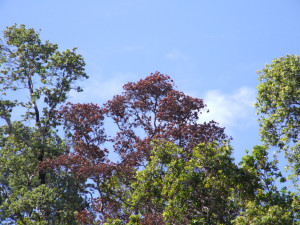 Invasive Initiative: The state’s ability to deal effectively with invasive species has been sorely challenged of late, with the rapid spread of the little fire ant, coconut rhinocerous beetle, coffee berry borer, coqui frogs, weeds too numerous to count, and the recent looming threat of the fungus causing rapid `ohi`a death.
Invasive Initiative: The state’s ability to deal effectively with invasive species has been sorely challenged of late, with the rapid spread of the little fire ant, coconut rhinocerous beetle, coffee berry borer, coqui frogs, weeds too numerous to count, and the recent looming threat of the fungus causing rapid `ohi`a death.
To its credit, the state Department of Agriculture, charged by law with addressing invasive species of all sorts, sought in October to explore the feasibility of establishing a new agency, attached to the department, that would address “invasive species and biosecurity coordination among state and federal partners.” It proposed to do this with a series of meetings facilitated by Peter Adler, doing business as The Accord Group. Adler’s history of mediating difficult issues goes back at least as far as his facilitation of meetings in the 1980s that led ultimately to passage of the Hawai`i Water Code.
The DOA submitted a request for exemption from the state’s bidding process to the chief procurement officer in mid-October. Under the scenario outlined in an attached justification, the department anticipated that Adler would hold a series of meetings with stakeholders from mid-October through December 4, with Adler providing the DOA with a summary of their concerns by December 10. For this, the DOA proposed to spend $14,052.57.
The request was disapproved on November 2, with the chief procurement office’s Bonnie Kahakui stating that it “lacks sufficient justification… Based on the vendor’s proposal, work includes creating surveys, conducting interview [sic], preparing reports, consulting with the project lead etc. These are consulting activities versus facilitation. The department shall use the appropriate method of procurement for the required services (i.e., Request for Proposals…).”
As of press time, the DOA had not posted any RFP on the state’s website.
Rapid `Ohi`a Death: Speaking of `ohi`a wilt, the fatal fungus has now spread to the western side of Hawai`i island – specifically, near Holualoa and Kealakekua.
For the latest information on the disease, see http://www.rapidohiadeath.org. J.B. Friday, the extension forester with the University of Hawai`i’s College of Tropical Agriculture and Human Resources, updates the site regularly. Also available on the site is a printable three-panel brochure about the disease, a link to an October presentation at the Hawai`i Volcanoes National Park, and much more useful information.
GEMS Still Batting Zero: For the first 10 months of its existence, the Green Energy Market Securitization program (GEMS), financed with $145 million in bonds to help underserved homeowners and renters obtain energy-saving technologies they are otherwise priced out of, issued no loans at all.
That is according to the latest report that the Department of Business, Economic Development, and Tourism submitted to the Public Utilities Commission summarizing activities up to the conclusion of the third quarter of the program’s operation, ending September 30. The total number of completed applications received since the program launched in November 2014 is 149, 43 of which were from non-profit organizations able to qualify for loans of more than $150,000. Forty-one of those were classified as “under review,” while two were declined.
A total of 106 residential applications were received, 35 of which were declined, five withdrawn, and 66 “under review.”
A financial summary reported that GEMS’ current assets amounted to $145,891,273.34 as of September 30. Expenditures of $111,909.27 – all for the cost of administering the program – were offset by just $6,437.26 in interest.
But the “financial summary” does not tell the whole story. According to a worksheet that Hawaiian Electric gave DBEDT last May, from December 1, 2014 through June 30, the company anticipated that Green Infrastructure Fee collections from utility customers would total $7,976,862.60. That entire amount — 45 percent of which comes from residential ratepayers – goes to pay the principal and interest on the GEMS bonds. By the year’s end, the utility will need to collect $7,940,691.56 more to fulfill “revenue requirements” for GEMS.
Framed another way, GEMS has cost electric ratepayers more than $15 million since November of 2014. And as of September 30, the state had not one kilowatt of renewable energy installed to show for it.

Leave a Reply